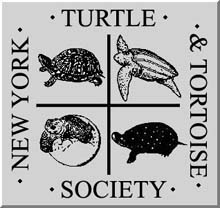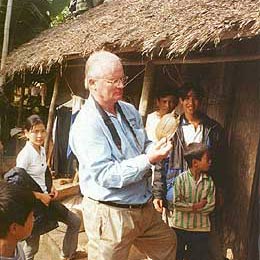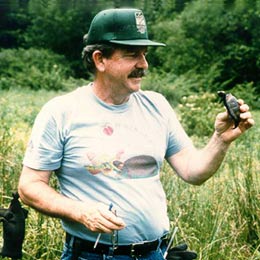 |
 |
The New York Turtle and Tortoise Society announces

Seminar 2003

Saturday, March 15, 9:00 A.M.–5:00 P.M.

The Hudson River Museum
511 Warburton Avenue
Yonkers, New York 10701
|
| Program |

Hudson Riverama, the Compelling Tale of a Wondrous Waterway — Now at the Hudson River Museum, a permanent, new $1.8-million teaching gallery tells the river’s story and explores the challenges of preserving the historic Hudson. Opening the day’s events will be a special tour though this new exhibit, conducted by Hudson River Museum Science Coordinator and Project Manager Steven Ruff. See Hudson Riverama.
|

James Gibbs in his laboratory at the State University of New York in Syracuse
|
 James Gibbs, Associate Professor, Conservation Biology & Wildlife Management, State University of New York, Syracuse
James Gibbs, Associate Professor, Conservation Biology & Wildlife Management, State University of New York, Syracuse
“Can Road Mortality Limit Turtle Populations?”
New research provides a compelling explanation for the bewildering decline of turtles in our environment, particularly the mobile land turtles and semi-aquatic species.
James Gibbs and SUNY colleague Gregory Shriver simulated the movements of three groups of turtles: land turtles, and large and small pond turtles. They then integrated the simulated turtle movements with road densities and traffic volumes. The results suggest that roads threaten both land turtles and large pond turtles: in many regions more than 5 percent of these turtles are likely to die while crossing roads, which is more than the populations can sustain.
Turtle roadkill was particularly high in the northeast, southeast and Great Lakes-Big Rivers region, which is where U.S. roads and traffic are concentrated. Even small pond turtles may be threatened by collisions in heavily roaded and trafficked areas. Daily traffic volumes typical of many major and arterial highways suggest that such roads are essentially impenetrable to any wandering turtle.
To help protect pond turtles in developed areas, the researchers recommend establishing buffer zones around aquatic habitats; for land turtles, the establishment of near roadless habit areas; and in areas where buffer zones and large roadless areas are not feasible, turtles could be protected by building road crossings.
|

Peter Pritchard examines a Chinese softshell turtle, Pelodiscus sinensis, while touring in nothern Vietnam in 2000.
|
 Peter C. H. Pritchard, Chelonian Research Institute, Oviedo, Florida
Peter C. H. Pritchard, Chelonian Research Institute, Oviedo, Florida
“On the Trail of Rafetus swinhoei”
This past November the quest for the world’s largest freshwater turtle took Peter Pritchard north into China. Dr. Pritchard will chronicle his adventure through southern China as he discovers undocumented museum specimens as well as three truly ancient captive animals. On a map of China we can trace his route: from Shanghai northwest to Suzhou and Nanjing and back southeast to Hangzou, then west across the country to Chengdu (Sichuan province), south to Kunming (Yunnan province, which included overland trips south to Gejiu and Hekou and back to Kunming), then east to Guangzhou (to survey the large turtle markets), and finally a flight to Haiku, Hainan, which included interior fieldwork on the island.
  Attendees of Seminar 2001 will recall Peter’s tour through northern Vietnam in the fall of 2000 (photo, left), with Le Thien Duc from Hanoi, the first intenational Asian intern at the Wetlands Institute, as his guide. This time, another Asian Scholarship Program intern, Jichao Wang from Hainan, served as Peter’s guide throughout the China tour. Jichao is a student of Shi Haitao, department head and director of the Biodiversity Museum at Hainan Normal University.
Attendees of Seminar 2001 will recall Peter’s tour through northern Vietnam in the fall of 2000 (photo, left), with Le Thien Duc from Hanoi, the first intenational Asian intern at the Wetlands Institute, as his guide. This time, another Asian Scholarship Program intern, Jichao Wang from Hainan, served as Peter’s guide throughout the China tour. Jichao is a student of Shi Haitao, department head and director of the Biodiversity Museum at Hainan Normal University.
|

Robert Zappalorti finds an adult male bog turtle at the base of a sedge grass tussock in a mark-recapture study area.
|
 Robert Zappalorti, Herpetological Associates, Inc., Jackson, New Jersey
Robert Zappalorti, Herpetological Associates, Inc., Jackson, New Jersey
“The Ecology and Nesting Behavior of the Bog Turtle
(Clemmys muhlenbergii) at Three Pennsylvania Locations”
A five-year mark and recapture study, conducted at three sites in eastern Pennsylvania, focused on the ecology of adult bog turtles, Clemmys muhlenbergii. The hatching success of 95 bog turtle eggs from these three colonies was also studied, including comparisons of naturally incubated eggs with artificially incubated eggs.
Bog turtles lay their eggs in various species of Carex tussocks within their marshy habitat. Some females deposit eggs in community nest sites (up to 3 clutches have been found in one tussock).
The work included installing predator excluder cages on some of the nests after recording nests and eggs, as well as follow-up nest monitoring to observe the health and developmental progress of eggs, or to detect predator disturbance. Nest-monitoring continued until it had been determined the remaining eggs were not going to hatch.
Predation probably accounts for eggs missing from unprotected nests, most likely carried off by a small mammal, which suggests this is an important contributing source of mortality at these three colonies. Although poorly understood, natural hatching success may also be reduced by infertility and weather-related developmental problems. Habitat management and conservation programs will also be discussed.
|
|
 |
|

